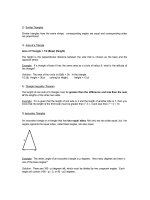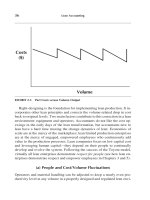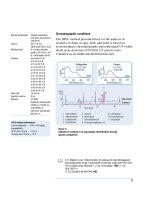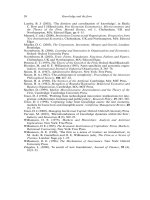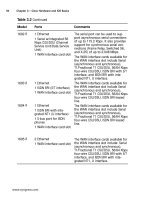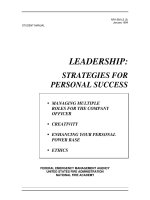LEADERSHIP STRATEGIES FOR PERSONAL SUCCESS phần 3 ppt
Bạn đang xem bản rút gọn của tài liệu. Xem và tải ngay bản đầy đủ của tài liệu tại đây (43.63 KB, 18 trang )
MANAGING MULTIPLE ROLES FOR THE COMPANY OFFICER
Role expectations may be defined as behaviors/attitudes which you
are expected to adopt/demonstrate when you are playing a specific
role. Each role carries with it a set of expectations which are
defined by:
SM MR-25
MANAGING MULTIPLE ROLES FOR THE COMPANY OFFICER
- Key senders significant others with whom you interact in
that specific role. (Example: In the husband role, the wife
would be a key sender; in the leader role, your subordinates
and your boss are key senders.)
- Yourself in each role you are also guided by your own
personal expectations of yourself.
Whenever you're not sure what's expected of you in any role,
you experience role ambiguity. This can cause stress, confusion,
feelings of inadequacy, and lack of direction.
ROLE CONFLICT
Intrarole conflict is conflict within one specific role. It is a stress
associated with performing the duties essential to the role.
Intrarole conflict occurs when:
- Your personal expectations conflict with the expectations
of one or more key senders. (Example: As CO you expect
yourself to act with sensitivity, but your crew expects you to
be tough.)
-The expectations of one key sender conflict with the
expectations of another key sender. (Example: A CO
receiving conflicting demands from superiors and
subordinates.)
Interrole conflict is conflict between two or more roles. The
demands of one role conflict with the demands of another role and
you feel required to fulfill both sets of demands. (Example: Study
of police personnel during the Texas City Disaster (Andrews &
Baird). Police officers were torn between duty to the department or
to their own families. Most chose family over department.
Interpersonal role conflict is conflict between two or more
individuals playing parallel roles. (Example: Two parents
disagreeing about how to discipline a child; station officers on
different shifts disagreeing about station maintenance priorities.)
Resolving or balancing role conflicts is a matter of clearly
delineating your priorities. Which roles are most important?
Whose expectations have priority?
Individuals who handle role conflict well share some common
characteristics. They show a preference for taking initiative; they
SM MR-26
MANAGING MULTIPLE ROLES FOR THE COMPANY OFFICER
exhibit both confidence and persuasiveness; they exhibit social
poise, spontaneity, and talkativeness; and show a preference for
flexibility when taking action. They exhibit a strong desire to
affiliate with people; have moderate desires for achievement and
power; possess the ability to reach their own conclusions despite
coercive pressure from others; hold a personal view that rewards
come from the success of the task or project, not just from personal
accomplishment; show the tendency to attach high priorities to
planning and goal-setting activities; show a general lack of
excessive feelings of pressure; and are in general agreement with
the policies of the department.
THE CO AS A ROLE MODEL
The CO has the responsibility to do the best possible job with the
resources assigned to his/her control. Remember, your
subordinates are watching you. This means becoming an effective
role model a person that both subordinates and peers can look
up to. Becoming an effective role model means being a
professional. Professionalism is a composite of personal skills and
attitudes (the "ABCDE's"): Attitude, Behavior, Communication
skills, Demeanor, and Ethics.
Attitude: One's state of mind or how you feel about your
leadership role. Artifactual communication is the message sent by
one's appearance, attire, and adornments; in other words, your
personal image. Be physically fit. Be clean and neat in your
personal dressing habits. Exhibit good personal hygiene. Maintain
a positive attitude.
Remember the adage: "Your attitude is showing!"
ATTITUDE EXAMPLE
An elderly Spanish-speaking gentleman received a letter
from his son who was away in college.
Not knowing how to read English he asked his young
granddaughter whom he should get to read the letter for
him.
The granddaughter suggested he should get the meat
market owner to read the letter to him.
SM MR-27
MANAGING MULTIPLE ROLES FOR THE COMPANY OFFICER
The old man took his granddaughter and went to see the
owner of the meat market. The old man asked the man at
the meat market if he would read the letter for him. The man
rudely grabbed the letter, read it to himself, tossed it back to
the old man, and said, "Your son wants $100."
As the old man and his granddaughter left the store his
granddaughter asked the old man what he was going to do,
and he answered, "With that kind of attitude, I won't send
him a penny."
The granddaughter convinced her grandfather to have the
barber read the letter for him again.
As the old man walked into the barber shop the owner
greeted the old man with a big smile and asked him what he
could do for him.
The old man handed him the letter and asked him if he
would read it for him. The barber said he'd be glad to read
the letter.
He started, "Dear Mom and Dad, How are you? How is the
rest of the family? Dad, I have run into a problem. It
appears that my tuition is $100 more than I anticipated.
know that you too are short on money and if you can't send
me the money I'll understand. But if you can, I will
appreciate it. I miss you and mom. Love, your son."
As they left the barber shop, again his granddaughter asked
what was he going to do.
The old man looked at his granddaughter and said, "Now
that my son has changed his attitude, I'll send him $300."
Behavior: Simply put, behavior is how you act. Your behavior
will directly affect the behavior of your subordinates. Professional
COs will: exercise self-discipline, maintain control over their
emotions, and exercise moderation and discretion off-duty as well
as on-duty.
Communication: How leaders get their message across. The CO
accepts the responsibility of being in the "people" business versus
the "things" business he/she previously dealt with as a firefighter.
Communication skills include: oral communication command of
language, professionalism; written communication how effectively
SM MR-28
I
MANAGING MULTIPLE ROLES FOR THE COMPANY OFFICER
can you write?; and nonverbal communication communicating
without words.
Demeanor: The bearing of the supervisor, or the sum total of A, B,
and C. Demeanor can be managed. Conscious awareness of
problems in the areas of appearance, behavior, and
communication skills will enable us to work on eliminating these
problems. Remembering the mission and goal of the organization
can help us to make our attitude more productive. Considering the
consequences for poor behavior can help us break bad habits.
College courses, speakers' groups, and self-development courses
can help us to improve our communication skills.
Ethics: Ethics involve conforming to the standards of conduct for
a given profession. Lack of ethics can destroy respect for a
supervisor.
Qualities of the Supervisor as Role Model:
Enthusiasm: You must display enthusiasm if you expect your
subordinates to become interested and enthused.
Initiative: Recognize the need for action and act accordingly.
Self-discipline: Control your own behavior and emotions.
Courage: Not only physical, but moral courage; the officer must
be able to stand up to resistance and criticism if necessary.
Integrity: Being honest and maintaining personal integrity in all
aspects of your life.
Loyalty: To both superiors and subordinates.
Good judgment and decisiveness: Allows us to size up a
situation and use mature judgment.
Empathy: Understanding where the other person is coming from.
Discretion: The exercise of prudence and common sense when
making decisions.
Desire for self-improvement: The genuine desire to build on our
strengths and improve our weaknesses.
Summary of the CO serving as a role model. Professionalism in
the form of the "ABCDE" approach will help to ensure status as a
SM MR-29
MANAGING MULTIPLE ROLES FOR THE COMPANY OFFICER
professional. The CO should always remember: "Your employees
will be watching you!"
ACCOUNTABILITY
All roles that the CO must assume fall into one of four areas of
accountability:
Accountability to self. We are all accountable to ourselves first.
We must be able to live with our decisions/actions. We are often
harder on ourselves than others are.
SM MR-30
MANAGING MULTIPLE ROLES FOR THE COMPANY OFFICER
Accountability to the company. As we have unique personalities
and standards, so does our company. The "norm" in one company
may not be the same in another company. (Example: Working on
personal vehicles on company time.) One job of the supervisor is
to look out for the personnel assigned to him/her.
Accountability to the organization. As supervisors, you are a
formal (and informal) representative of management. Blaming
upper management for your problems will generally come back to
haunt you! Your actions and professionalism as a CO can help to
motivate others, and, ultimately, the organization itself.
Accountability to the public. We should always remember that
our sworn duty is to protect and serve the public. The department
mission must be carried out. The more efficient and effective we
are as COs, the better the service we can provide. The better our
company can work together as a team, the better the job it will do
for the community.
THE LEADERSHIP ROLE
Henry Mintzberg analyzed the leadership role through observation
and research. He concluded that effective leaders perform 10
critical functions in their assigned area of responsibility.
Interpersonal Functions
Figurehead: The performance of ceremonial duties. (The CO at
the annual awards ceremony; the CO awarding prizes to
elementary school children participating in a fire prevention poster
contest.)
Leader: Taking the direct actions typical of a leader; directing,
ordering, counseling, disciplining. (The CO directing personnel on
the emergency scene; the CO conducting a counseling session.)
Liaison: Making contacts with others serving as a link. (CO
meeting with builders on a construction site; CO linking
management and subordinates.)
Informational Roles
Monitor: Scanning the environment for critical information; staying
on top of things. (The CO "360s" the building during size-up; the
CO keeps up with new technology.)
SM MR-31
MANAGING MULTIPLE ROLES FOR THE COMPANY OFFICER
Disseminator: Giving out information others would not otherwise
have. (CO holding a meeting with personnel; CO acting as a
coach with new recruit.)
Spokesperson: Giving information to people outside of your unit.
(CO addressing homeowner's association on the value of smoke
detectors in the home; CO serving as departmental PIO.)
Decisional Roles
Entrepreneur: Seeking to improve the unit through necessary new
approaches resulting from changes in the environment. (CO
designing new preplan form on computer; officer "commandeer-
ing" the use of heavy construction equipment to help control spill of
hazardous materials.)
Disturbance handler: Responding to unexpected conflicts. (CO
dealing with an argument between two of his/her subordinates;
officer dealing with an unruly crowd on the scene of an emergency
incident.)
Resource allocator: Deciding who will get what and do what. (CO
assigning daily station maintenance; officer assigning units to tac-
tical positions on the scene of an emergency while serving as IC.)
Negotiator: Settling issues and resolving conflicts. (CO dealing
with the first step of a union grievance; officer serving as member
of a task group containing wide representation from various
segments of the community.)
SUMMARY
1. In order to be a successful manager, the CO must manage a
variety of roles, both inside and outside the organization.
2. Role conflicts are an inevitable fact of organizational life; it
is up to the individual manager to understand the conflicts
and apply the proper balancing strategy.
3. The CO must be able to apply a balancing strategy between
roles that will enable him/her to function effectively in
various positions.
4. Four areas of accountability for the CO include accounta-
bility to self, to the company, to the organization, and to
the public.
SM MR-32
MANAGING MULTIPLE ROLES FOR THE COMPANY OFFICER
5. As a role model, the CO should always remember: "Your
subordinates are watching you!"
SM MR-33
MANAGING MULTIPLE ROLES FOR THE COMPANY OFFICER
SM MR-34
MANAGING MULTIPLE ROLES FOR THE COMPANY OFFICER
GLOSSARY
1. Interpersonal role A conflict between two or more individuals in parallel
roles.
2. Interrole conflict A conflict between two different roles.
3. Intrarole conflict A conflict within a specific role.
4. Leadership function An organizationally expected behavior pattern
because of one's status within the organization.
5. Professionalism A composite of attitude, behavior, communication
skills, demeanor, ethics (A,B,C,D,E).
6. Role A part that an actor or actress plays in a performance; a function or
office assumed by someone.
7. Role model A person that both subordinates and peers can look up to.
SM MR-35
MANAGING MULTIPLE ROLES FOR THE COMPANY OFFICER
SM MR-36
MANAGING MULTIPLE ROLES FOR THE COMPANY OFFICER
BIBLIOGRAPHY
Andrew, Patricia H., and Baird, John E., Jr. (1986) Communication for Business
and the Professions. Brown Publishing Co. Dubuque, IA.
Boy Scouts of America. (1981). Leadership Skills Summary. Boy Scout Leader
Wood Badge.
Burkell, Charles J. (3/83). "The Fire Chief's Roles and Relations." Fire Chief
Magazine. Chicago, IL.
Carlson, Gene (1/84). "Firefighters Beget Officers." Fire Engineering Magazine.
New York, NY.
Fisher, Dalmar, (1981). Communication in Organizations. West Publishing
Company. St. Paul, MN.
International City Management Association. (1984). Effective Supervisory
Practices. 2nd Edition. Washington, DC.
Mintzberg, Henry. "The Manager's Job: Folklore and Fact." Harvard Business
Review. July-August, 1975.
Zucco, Karen K. (1987). Interview and reference information. Illinois Central
College. East Peoria, IL.
SM MR-37
LEADERSHIP
CREATIVITY
OBJECTIVES
The participants will:
1. Define creativity and innovation.
2. Identify the importance of creativity and innovation in fire service organizations.
3. Analyze the elements of creativity.
4. Identify the 5 steps of the creative process.
5. Evaluate personal blocks to creativity.
6. Identify ways of fostering creativity in subordinates.
7. Identify effective techniques for selling new ideas.
8. Develop strategies to enhance creative leadership traits.
CREATIVITY
SM CR-3
CREATIVITY
I. WHAT IS CREATIVITY? WHAT IS INNOVATION? WHY ARE THEY
IMPORTANT?
A. Define creativity in your own words.
B. Define innovation in your own words.
C. Importance of creativity.
1. To keep up with external changes.
2. To assure state-of-the-art methods and techniques.
D. Debunking prevalent myths.
(NOTE: All myths and realities are contained in the narrative
section.)
II. ELEMENTS OF CREATIVITY
List as many round objects as you can in 4 minutes.
SM CR-4
CREATIVITY
A. Element #1: Fluency the quantity of ideas you can generate in a
specified period of time.
B. Element #2: Flexibility the ability to generate ideas in different
categories.
1. Breaking through mental barriers.
2. Free association.
C. Element #3: Originality the ability to generate unusual ideas.
D. Element #4: Awareness the ability to see beyond the obvious.
E. Element #5: Drive refusing to give up.
III. THE CREATIVE PROCESS
A. Preparation getting ready; becoming aware of a need/potential for
improvement.
B. Concentration generating ideas.
C. Incubation "sleeping on it."
D. Illumination getting the answer.
E. Verification/Production testing.
SM CR-5



